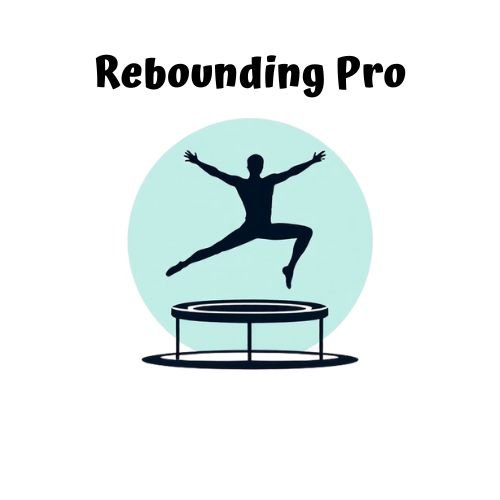Jumping burns considerably more calories than walking—11.7 calories per minute compared to 5.2-7.2 for walking. Even low-intensity jumping burns 10-12 calories per minute, while walking only burns 4-5 calories. You’ll achieve a 200-calorie burn in just 15-20 minutes of jumping versus 35-50 minutes of walking. Plus, rebounding or trampoline exercise activates more muscle groups simultaneously with 68% greater efficiency. Discover how this low-impact activity can transform your weight management routine.
The Science Behind Rebounding Calorie Burn

The dynamic activity of rebounding on a mini-trampoline delivers impressive calorie-burning efficiency compared to traditional exercises.
You’ll burn the same calories in 20 minutes of rebounding as you’d during 30 minutes of jogging—while experiencing it as 10% less strenuous.
On average, rebounding burns between 6.9 and 12.4 calories per minute, depending on your intensity level.
For perspective, a 155-pound person can torch about 223 calories during a moderate 30-minute session, while someone weighing 140 pounds might burn 405 calories in 40 minutes.
This efficiency stems from how rebounding elevates your heart rate while simultaneously engaging multiple muscle groups.
The rhythmic bouncing motion stimulates your cardiovascular system comparable to jogging, but without the harsh impact on your joints.
According to a NASA study, the biomechanical stimuli from trampoline jumping produces greater benefits than running at a lower metabolic cost, making it an exceptionally efficient exercise option.
Walking vs. Jumping: Calories Per Minute Comparison
You’ll burn substantially more calories jumping than walking when comparing minute-for-minute, with jumping activities like rope skipping consuming nearly twice the energy at 11.7 calories per minute versus walking’s 5.2-7.2 calories at a brisk pace.
This dramatic difference stems from jumping’s higher metabolic demands, which elevate your heart rate more quickly and engage additional muscle groups throughout your body. Walking uphill can increase your calorie burn by 10-30% more compared to walking on flat surfaces.
The time efficiency of jumping makes it an excellent option for those with busy schedules, though walking remains valuable for longer, sustainable exercise sessions that accumulate significant calorie burn over time.
Intensity’s Caloric Impact
When comparing calorie-burning potential, jumping rope remarkably outperforms walking regarding energy expenditure per minute. The difference is substantial: while low-intensity walking burns only 4-5 calories per minute, even low-intensity rope jumping burns 10-12 calories—more than double the amount.
As you increase intensity, the gap widens further. Medium-intensity jumping rope burns 14-17 calories per minute compared to walking’s modest 6-7 calories. At high intensity, jumping rope can torch up to 20 calories per minute.
This efficiency stems from thorough muscle engagement. Jump rope offers a comprehensive cardiovascular workout that engages large muscle groups and substantially increases your heart rate. Jumping rope activates your arms, legs, and core simultaneously, while walking primarily works your legs with minimal upper body involvement.
For maximum caloric burn in minimal time, jumping rope clearly offers the more efficient workout option.
Time Efficiency Breakdown
While most people understand that jumping burns more calories than walking, seeing the exact numerical breakdown reveals just how significant this difference truly is.
Jumping exercises burn 10-16 calories per minute, 2-3 times more than moderate walking at 3 mph (4-5.6 calories per minute).
This efficiency gap translates to real-world time savings: you’ll burn 200 calories in just 15-20 minutes of jumping compared to 35-50 minutes of walking.
Even brisk walking (4-5 mph) at 6.3-7.7 calories per minute falls short of jumping’s efficiency. Speed and weight are the primary factors that affect your calorie burn rate during any exercise.
Stair walking provides middle ground at 8-9 calories per minute.
If you’re time-constrained, jumping activities offer superior caloric return on your time investment, though they do require greater fitness levels and coordination.
Metabolic Rate Differences
The metabolic differences between walking and jumping become starkly apparent when examining their calorie-burning potential minute by minute.
While walking burns a modest 3-5 calories per minute, jumping rope can torch an impressive 15-20 calories in the same timeframe.
This stark contrast stems from jumping rope’s full-body engagement. You’re activating your arms, shoulders, core, and legs simultaneously, markedly elevating your heart rate and energy expenditure.
Walking primarily engages your lower body at a lower intensity.
For a 150-pound person, a 30-minute jump rope session can burn 500-600 calories compared to walking’s 100-150 calories.
Your weight influences these numbers—heavier individuals burn more in both activities. This is supported by data showing that a 185-pound individual burns substantially more calories than a 125-pound person doing the same exercise.
The efficiency difference is clear: you’ll achieve greater caloric expenditure in less time when jumping rope versus walking.
How Rebounding Engages More Muscle Groups
Unlike walking that primarily works your legs, rebounding activates an extensive network of muscles throughout your entire body.
Your core muscles—including abs, obliques, and lower back—engage continuously to maintain balance on the unstable surface while supporting your posture during jumps.
Every bounce activates your quadriceps, hamstrings, calves, and glutes while reducing joint stress compared to running on hard surfaces.
When you add arm movements like openers or raises during jumps, you’re engaging your shoulders and upper body muscles simultaneously.
What’s unique about rebounding is how it targets deep stabilizing muscles, including your pelvic floor, which rarely get activated during regular walking.
These thorough muscle engagement patterns not only burn more calories but also improve coordination, balance, and functional strength throughout your entire body. Trampolining is a low impact exercise that provides high-effect results while minimizing strain on your joints.
Metabolic Benefits of Low-Impact Trampoline Exercise

Considering the surprising findings from NASA research, rebounding on a mini-trampoline stands out as a metabolic powerhouse compared to other low-impact exercises. Your body experiences significant hormonal stimulation during trampoline workouts, with HGH increasing by 300% after just 10 minutes of bouncing and adrenaline rising by up to 97%. Studies have confirmed that rebounding is 68% more efficient than jogging for cardiovascular conditioning.
| Metabolic Benefit | Trampoline | Walking |
|---|---|---|
| Calorie Burn | 135-200 calories/30 min | Less per equivalent time |
| Post-Exercise Effect | Increased mitochondrial production | Limited afterburn |
| Muscle Engagement | Full body activation | Primarily lower body |
These benefits extend beyond your workout time as improved oxygen circulation enhances cellular energy production and waste removal. You’ll also build muscle mass more effectively, which naturally increases your resting metabolic rate and transforms your body composition.
Joint-Friendly Workouts That Maximize Calorie Expenditure
For individuals with joint concerns, finding exercises that deliver maximum calorie burn while minimizing stress on vulnerable areas presents a welcome challenge.
You don’t have to sacrifice effective workouts when protecting your joints. Alternating between high-intensity intervals and recovery periods maximizes calorie burn even during shorter workout sessions.
These joint-friendly options maximize your calorie expenditure:
- Cycling – Burns 600-750 calories hourly while being gentle on joints; adjust resistance for intensity without added impact
- Swimming – Torches around 716 calories per hour with full-body engagement and virtually zero joint stress
- Water-based HIIT – Combines interval training principles with water’s natural resistance for intensive calorie burn
- Rowing – Burns approximately 333 calories in 45 minutes while strengthening your upper back and core
Consider incorporating hydrotherapy or resistance band intervals for variety while maintaining joint protection throughout your fitness journey.
Transforming Fat Through Rebounding Intervals

When seeking effective fat loss methods, rebounding intervals stand out as a powerfully efficient option. NASA research confirms it’s up to 68% more effective at burning calories than walking or running, engaging multiple muscle groups simultaneously.
You’ll see real results with just 15-20 minutes of rebounding 3-5 times weekly. The workout elevates your heart rate into fat-burning zones while improving your resting metabolic rate—meaning you’ll burn calories even after finishing. High-quality rebounding creates increased G-Force during workouts, leading to enhanced caloric expenditure compared to traditional exercises.
Unlike traditional cardio, rebounding enhances insulin sensitivity and stimulates your lymphatic system, helping detoxify your body and restructure fat storage.
For best results, incorporate interval training by alternating between high and low-intensity bouncing. This approach maximizes fat oxidation while remaining gentle on your joints.
Mini-Trampoline Workouts for Weight Management
Mini-trampoline workouts offer one of the most effective solutions for weight management available today. The bouncing motion burns more calories than walking while simultaneously protecting your joints, making it ideal for consistent, long-term exercise.
Your body benefits in four key ways:
- Enhanced calorie burn – Rebounding exercises burn fat more efficiently than running or power walking while engaging your entire body.
- Improved cardiovascular health – Regular sessions strengthen your heart, improve circulation, and boost oxygen delivery for peak fat metabolism.
- Greater muscle engagement – The unstable surface activates your core and stabilizing muscles more intensely than walking. You can easily fit these exercises into your daily routine with short burst sessions throughout the day, adding up to effective weight management without major time commitments.
- Increased adherence – The low-impact, enjoyable nature encourages consistency without pain, even for those with joint issues or obesity.
The Afterburn Effect: Why Rebounding Burns Calories Longer
While walking provides a steady calorie burn during exercise, rebounding delivers a powerful metabolic advantage that continues long after you’ve stepped off the trampoline.
This phenomenon, known as excess post-exercise oxygen consumption (EPOC) or the afterburn effect, can keep your metabolism elevated for up to 48 hours.
The intensity of rebounding triggers significant hormonal responses that sustain this metabolic boost.
With a MET value of 7.2—higher than many aerobic activities—rebounding engages more muscle groups and challenges your cardiovascular system more intensely than walking. Studies show that rebounding can burn approximately 12.4 calories per minute for some individuals, making it highly efficient for weight management.
A 40-minute session can burn approximately 405 calories for a 140-pound person, plus additional calories during recovery.
Unlike walking’s minimal afterburn, rebounding’s intensity means you’ll continue burning calories while your body repairs muscles and restores itself.
Customizing Your Rebounding Routine for Optimal Calorie Burn
To maximize calorie burn during rebounding, customizing your routine based on personal factors can yield markedly better results than a one-size-fits-all approach.
By adjusting key variables, you’ll enhance both immediate calorie expenditure and long-term metabolic benefits.
- Intensity variations – Increase jumping height or frequency during high-intensity intervals, followed by low-intensity recovery periods.
- Duration adjustments – Extend your sessions from 10 to 30 minutes to more than double your calorie burn.
- Accessory integration – Add hand weights or resistance bands to increase energy expenditure while engaging more muscle groups.
- Movement diversity – Incorporate dynamic movements like high knee jumps, side-to-side motions, or jogging in place to elevate heart rate and intensity. Research shows rebounding engages all body cells almost 100 times per minute, significantly enhancing cellular metabolism and energy usage.
Remember that consistency remains vital for creating a sustained calorie deficit over time.
Tracking Progress: Measuring Calorie Burn on a Rebounder
To accurately track your calorie burn while rebounding, you’ll need reliable measurement tools rather than guesswork.
Heart rate monitors offer real-time feedback on workout intensity, helping you maintain the ideal fat-burning zone during your sessions.
Many digital fitness apps can now sync with these devices, calculating calories based on your heart rate, weight, and exercise duration for a more personalized assessment of your rebounding workouts. The accuracy of these calculations depends heavily on your individual metabolic equivalent of task values, which vary based on the specific rebounding techniques you use.
Tracking Progress: Measuring Calorie Burn on a Rebounder
Fitness enthusiasts looking to maximize their workouts need reliable ways to track calories burned on a rebounder. While rebounding can burn calories comparable to jumping rope (250-300 calories in 15 minutes), several factors affect your results.
To accurately track your calorie expenditure while rebounding:
- Use fitness trackers with heart rate monitors to get more precise measurements than accelerometer-only devices.
- Record your session duration and intensity—higher jumps and faster pace greatly increase calorie burn.
- Consider your body weight when calculating results—heavier individuals typically burn more calories.
- Stick with one tracking method consistently to monitor progress over time rather than comparing across different devices.
Remember that rebounding combines aerobic and strength benefits while being gentler on your joints than high-impact activities like running. For optimal results, try incorporating HIIT workouts into your rebounding routine to continue burning calories for up to 24 hours after exercise.
Heart Rate Monitoring Tools
Accurately tracking calories burned during rebounding requires reliable heart rate monitoring tools, which serve as the foundation for any serious fitness tracking regimen. Your options include chest straps like the Garmin HRM-Pro for precise measurements, comfortable armbands such as the Wahoo TICKR FIT, or wrist-based monitors like the Apple Watch or Fitbit Versa 4. Chest straps are generally considered the most accurate for heart rate monitoring during high-intensity activities like rebounding.
| Monitor Type | Best For | Emotional Benefit |
|---|---|---|
| Chest Strap | Maximum accuracy | Confidence in your data |
| Armband | Comfortable workouts | Freedom during rebounding |
| Wrist Watch | All-day tracking | Motivation through visibility |
| Multi-Use | Versatile activities | Adaptability to your lifestyle |
When selecting your monitor, consider water resistance for sweat-heavy rebounding sessions, battery life for extended use, and connectivity features that sync with your existing devices.
Digital Fitness Applications
Digital fitness applications have revolutionized how we track calorie burn during rebounder workouts, offering precision that manual calculations simply can’t match. These apps transform your phone or smartwatch into a powerful tool for monitoring your jumping sessions.
Most rebounding apps provide tailored tracking through:
- Specialized jump metrics that measure frequency and height of bounces
- Real-time feedback that adjusts calorie calculations based on your intensity
- Personalized profiles that factor in your weight, age, and baseline metabolism
- Progress visualization showing your calorie burn trends over days, weeks, and months
Unlike generic fitness trackers, rebounder-specific apps use accelerometer data to detect your unique jumping patterns, delivering more accurate calorie estimates than walking trackers.
You’ll get approximately 10-20 calories burned per minute jumping versus 3-5 walking.
Frequently Asked Questions
How Does Jumping Impact Hormonal Balance Compared to Walking?
Jumping triggers stronger hormonal responses than walking, boosting your growth hormone, catecholamines, and cortisol levels considerably. You’ll experience greater metabolic impact, muscle growth stimulus, and fat mobilization when you jump versus walking’s gentler hormonal effects.
Can Jumping Exercises Improve Bone Density More Effectively Than Walking?
Yes, you’ll build bone density faster with jumping exercises than walking. Jumping creates high-impact mechanical stress that stimulates osteoblast activity and bone formation, while walking’s lower-impact nature produces minimal bone remodeling effects.
Does Jumping or Walking Burn More Calories During Pregnancy?
While jumping normally burns more calories than walking, during pregnancy walking is the safer choice. You’ll burn calories effectively with walking without the risks that jumping’s high-impact movements pose to your changing body.
How Do Outdoor Vs Indoor Jumping Workouts Compare for Calorie Burn?
You’ll typically burn more calories jumping outdoors due to uneven terrain, wind resistance, and temperature regulation demands. However, indoor jumping allows for longer, uninterrupted sessions that can compensate through consistent intensity and duration.
Do Children Burn Proportionally More Calories Jumping Than Adults?
Children don’t necessarily burn proportionally more calories jumping than you do. Their calorie burn efficiency is similar to adults when adjusted for body weight, though they might jump more frequently during play.
In Summary
You’ll burn considerably more calories jumping on a rebounder than walking at a moderate pace. Your body works harder against gravity while engaging multiple muscle groups simultaneously. The afterburn effect means you’ll continue burning calories hours after your rebounding session ends. For maximum weight management results, try incorporating interval training into your mini-trampoline routine and track your progress to stay motivated as you watch the calories melt away.





Leave a Reply